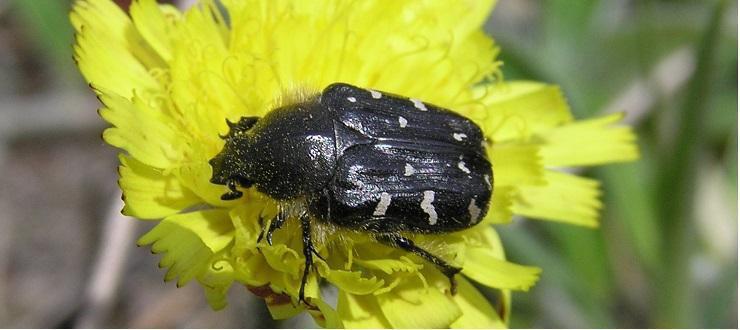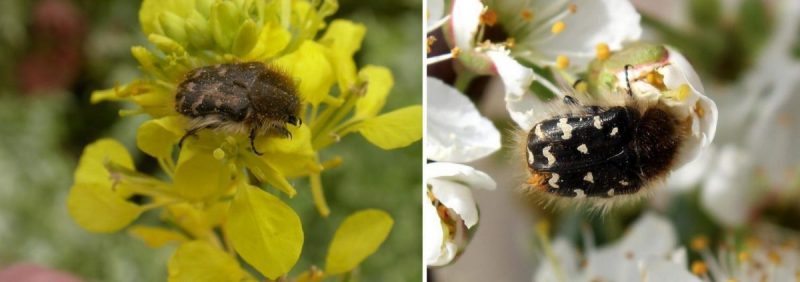Blossom feeder scarab (Tropinota hirta)- pest management

The blossom feeder scarab (Tropinota hirta, syn. Epicometis hirta) is a species widespread in Europe, North America, Asia, the Middle East. It is frequently found in the steppe and forest-steppe areas and it attacks trees, grapevines, and cruciferous crops during flowering.
Description. Adults are 9-12 mm long, have a matte black body, covered with yellow hairs that give it a hairy appearance. The elytra are provided with 6-8 white spots that are sometimes missing. The larva is 14-16 mm long, white-yellow, with a brown head.
Biology and ecology. The blossom feeder scarab has one generation per year and overwinters in the adult stage in the soil. In early spring (April) hibernating adults become active and fly on the flowers of various spontaneous plants until June-July. With the flowering of the fruit trees, adults migrate on their flowers, feeding on their internal organs. They prefer sunny days and at night they retreat to the ground. After mating, the female lays eggs in the surface layer of the soil, managing to lay up to 50 eggs. The new adults appear in August-September but remain in the pupal sacs to overwinter until the following spring.
Damage. It is a polyphagous species, it attacks fruit trees but also grapevines, rapeseed, and other cruciferous vegetables, even corn and other cereals during flowering. They cause significant damage to the floral organs. The damage is caused by the adults consuming the pollen, the internal organs of the flowers, and sometimes even the sepals.
In the case of attacking rapeseed crops, they consume the floral organs and sometimes the young leaves.
Pest management. Controlling this pest is quite difficult because it attacks during the flowering period and it is necessary to protect the useful entomofauna. Daily inspection of crops is recommended, especially on sunny mornings. Instead of chemical treatments, pheromone traps can be used or apply mechanical beetle removal by shaking the trees in the morning, when the beetles are numb.
The so-called trap crops recommended in tree and grapevine plantations can be set up. This method is based on the preference of adults for cruciferous vegetables. In the vicinity of orchards or vineyards, rapeseed or mustard rows are planted that will attract a part of the adult population, thus limiting the attack on the trees. Adults must be removed from the trap cultures and destroyed. In rapeseed crops, a hybrid with earlier flowering can be sown on the edge of the crop, functioning as a beetle trap and treatments can be performed only on these rows.
In orchards and vineyards, plowing between rows can be done in July, August, September, to destroy the adults buried in the soil. In the case of rapeseed, mustard, or other cruciferous crops, the land has to be plowed after harvest.
As a parasitoid species, Scolia hirta (a species of wasp) is known because it parasitizes the larvae of this pest. Clivina fossor Fall is a natural enemy that can destroy up to 65% of the pest’s pupae and larvae.
Treatments must be carried out with insecticides that are friendly to bees.
Recommended products
-
You can find products on a different store
Change Store -
You can find products on a different store
Change Store -
You can find products on a different store
Change Store -
You can find products on a different store
Change Store -
You can find products on a different store
Change Store -
You can find products on a different store
Change Store -
You can find products on a different store
Change Store -
You can find products on a different store
Change Store -
You can find products on a different store
Change Store -
You can find products on a different store
Change Store -
You can find products on a different store
Change Store -
You can find products on a different store
Change Store -
You can find products on a different store
Change Store -
You can find products on a different store
Change Store -
You can find products on a different store
Change Store -
You can find products on a different store
Change Store -
You can find products on a different store
Change Store -
You can find products on a different store
Change Store -
You can find products on a different store
Change Store -
You can find products on a different store
Change Store -
You can find products on a different store
Change Store -
You can find products on a different store
Change Store -
You can find products on a different store
Change Store -
You can find products on a different store
Change Store
















































































































































































































































































































































































































































